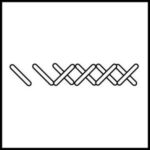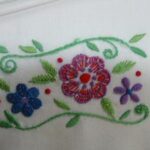Tattered jeans may seem stylish for some, but frayed fabrics flatter no one in the long run. How can you patch torn trousers, clean up tattered corduroys, repair ripped khakis, mend shredded chinos or re-stitch ragged blue jeans?
Don’t Trust Iron-On Patches
Variety stores and sewing shops often sell iron-on patches in denims, corduroys, and other fabrics. Color choices are limited, and the materials rarely match your torn jeans or trousers.
Often, iron-on patches tend to pull away from garments with continued wear and washing. For rugged clothing, such as blue jeans and khaki pants, iron-on patches are temporary solutions at best.
However, if you must, you can select an iron-on patch to repair your denims or khakis. First, you will probably want to trim the patch to fit the tattered area of your pants. Be sure to make the patch at least one-half of an inch larger (on all sides) than the area you plan to cover.
Preheat a steam iron to the hottest setting advised for the fabric content of your jeans or khakis. Turn your pants inside-out, and press them neatly on an ironing board, with the torn area centered and flat. Open out the ripped portion of your pants, and try to close up the tear as much as possible, as you iron.
Cover the tear with your iron-on patch. Press firmly and evenly, following the manufacturer’s instructions for the iron-on patch.
Turn your trousers or blue jeans right side out again, and iron them neatly before wearing. Of course, corduroys should always be pressed from the inside only, to prevent fading, flattening, and shining of the wales.
For added durability, you might stitch around the edge of the iron-on patch, either by hand-sewing or with your sewing machine. This will make your patch last much longer on your blue jeans or khaki pants.
Consider Appliques
If you must patch a pair of khakis or blue jeans, why not add a bit of bling at the same time? Many rips and tears can be mended with trims, store-bought appliques, emblems, patches, buttons or other adornments.
You might make your own appliqué or add a pocket to cover the torn area of your blue jeans or khakis.
Appliques and other embellishments may be affixes by hand sewing or using a sewing machine.
Open a Seam
Even with modern free-arm sewing machines, it can be difficult to maneuver a tight jean or pants leg inside the sewing head of the appliance. Here’s an easier way.
To mend a torn pair of khaki trousers or blue jeans, you must first open a section of the inseam of the pants leg you are repairing. The inseam is the inner leg seam of the jeans or trousers.
Turn the pants inside out. Use a seam ripper, straight-edge razor, or small scissors to remove the stitching on the inner leg seam. Begin several inches above the torn area, and open the inseam to several inches past it.
Most blue jeans and khakis have finished inseams, so you will have to remove both the straight seam and the loopy serged edge seam to open the leg.
Unfold the inseam, and press the seam allowances open on your ironing board.
Now you have a clean, flat area, so you can directly address the ripped portion of your khaki pants or blue jeans.
Stitch It Up
If the rip or tear is narrow and small, you may be able to repair it with a simple seam.
To do this, fold the leg of your blue jeans or khakis, so that the rip is closed. Begin machine-stitching about half an inch before the left-hand edge of the tear, and continue to about half-an inch after the other end of it.
Be sure to use a sturdy sewing machine needle, particularly for denims, corduroys or heavier khaki fabrics. Choose a mending stitch, which will finish the edge to prevent fraying, if possible.
Open out the pants or jeans leg, and press the new seam flat.
Choose Your Patching Fabrics
Of course, the simplest and sturdiest solution for repairing torn blue jeans or khakis is to create a patch for the tattered areas.
First, choose your fabrics. You may attempt to match the fabric in your blue jeans, corduroys or khaki pants. Ideally, you will have scraps on hand already, perhaps from cutting off outgrown blue jeans or other pants to create summer shorts. Possibly, you have a fabric chest or pile of remnants that may offer suitable patching materials.
If not, you can certainly purchase a small section of yardage at the sewing shop or variety store. Take your torn blue jeans, khaki trousers or corduroy pants with you to pick out your fabrics. Be aware that woven (non-stretch) jeans, khakis and corduroys should be mended with like fabrics, while knits (stretchy) will require their own sort of patches. Mixing wovens and knit fabrics is generally not a good idea, if you want your patches to remain on your khakis, corduroys or jeans.
Some stitchers choose contrasting or accent fabrics for patching torn pants. Florals, stripes, plaids and other textiles can make lovely patches. In fact, certain fashion designers purposefully use these materials on new, ready-made garments.
As you patch your jeans or trousers, you may actually be creating your own fashion statement.
Produce a Patch
After selecting your fabric, you will be ready to make your patch for your trousers or jeans.
Cut a piece of your patching fabric, at least half an inch larger (on all sides) than the hole in your pants. Create any shape you wish, keeping in mind that the easiest to manage is a simple square or rectangle. These instructions pertain to such shapes. (Please be advised that more complex patch shapes should be appliqued onto your pants, rather than stitched traditionally, as below.)
Using a hot steam iron (the hottest setting allowable for the patch fabric you are using), press your patch flat. With the right side facing down on your ironing board, tuck under a quarter of an inch on all four sides.
Prepare to Stitch
Place your patch, right side up, on the outside of your blue jeans or khakis, covering the torn area. Place fusible web tape between the patch and your ripped pants. Be careful that you do not place the fusible web in the actual tear, as you do not want to gum up the opening itself.
Iron the patch onto the garment, fusing them together with the fusible web.
Attach the Patch
Use a straight stitch on your sewing machine and a sturdy sewing needle, especially for heavy fabrics like corduroy, khaki or denim.
Beginning in one corner of your patch, machine-stitch all the way around. Be sure to stitch over your starting point, to lock your patching seam.
Re-Stitch the Seam
Once you have patched your pants or jeans, you will be ready to close up the inseam you previously opened.
Place right sides of your pant leg together, and pin the inner leg seam opening together. Machine-stitch the inseam closed, starting a bit before the opening and continuing afterwards. Be sure to lock your stitches at both ends, either by reverse-stitching or using a lock-stitch on your sewing machine. Serge the seam edges, or finish them with a zig-zag stitch to prevent fraying.
Press and Go
Turn your khakis, corduroys or blue jeans right side out, and press the pants as usual before wearing.




